Preface
Organization
Contents – Part I
Oral Session O1: Learning
Dual Generator Generative Adversarial Networks for Multi-domain Image-to-Image Translation
1 Introduction
2 Related Work
3 G2GAN: Dual Generator Generative Adversary Networks
3.1 Model Formulation
3.2 Model Optimization
3.3 Implementation Details
4 Experiments
4.1 Experimental Setup
4.2 Comparison with the State-of-the-Art on Different Tasks
4.3 Model Analysis
5 Conclusion
References
Pioneer Networks: Progressively Growing Generative Autoencoder
1 Introduction
2 Related Work
3 Pioneer Networks
3.1 Intuition
3.2 Encoder–Decoder Losses
3.3 Model and Training
4 Experiments
4.1 CelebA and CelebA-HQ
4.2 LSUN Bedrooms
4.3 Cifar-10
5 Discussion and Conclusion
References
Editable Generative Adversarial Networks: Generating and Editing Faces Simultaneously
1 Introduction
2 Related Work
2.1 Conditional GANs
2.2 Facial Attribute and Generation
3 Background
3.1 Connection Network
3.2 Selective Learning for Classification
4 Editable Generative Adversarial Networks
4.1 Formulation
5 Experiments
5.1 Qualitative Evaluation
5.2 Quantitative Evaluation
6 Conclusion
References
Cross Connected Network for Efficient Image Recognition
1 Introduction
2 Related Work
3 Cross Connected Network
3.1 Cross Connection
3.2 Pod Structure
3.3 Receptive Fields of Depthwise Convolutions
3.4 CrossNet Architecture
4 Implementation
5 Experiments
5.1 ImageNet-1k Dataset
5.2 MSCOCO Dataset
6 Conclusions
References
Answer Distillation for Visual Question Answering
1 Introduction
2 Related Work
3 Answer Distillation for Visual Question Answering
3.1 Overview
3.2 Answer Distillation
3.3 Answer Prediction
4 Experiments
4.1 Basic Configuration
4.2 Results
5 Conclusion
References
Spiral-Net with F1-Based Optimization for Image-Based Crack Detection
1 Introduction
1.1 Related Works
2 Spiral-Net
3 F1-Based Optimization
3.1 F1-Based Loss
3.2 F1-Guided Gradient Weighting
4 Experimental Results
4.1 Crack Dataset
4.2 Implementation Details
4.3 Performance Analysis on Spiral-Net
4.4 Comparison to Other Methods
5 Conclusion
References
Flex-Convolution
1 Introduction
2 Related Work
3 Method
3.1 Convolution Layer
3.2 Extending Sub-sampling to Irregular Data
4 Implementation
4.1 Neighborhood Processing
4.2 Efficient Implementation of Layer Primitives
4.3 Network Architecture for Large-Scale Semantic Segmentation
5 Experiments
5.1 Synthetic Data
5.2 Real-World Semantic Point Cloud Segmentation
6 Conclusion
References
Poster Session P1
Extreme Reverse Projection Learning for Zero-Shot Recognition
1 Introduction
2 Related Work
3 The Proposed Model
3.1 Problem Definition
3.2 Projection Learning
3.3 Model Formulation
3.4 Optimization
3.5 Discussion
4 Experiments
4.1 Datasets and Settings
4.2 Results Under Standard ZSL Setting
4.3 Results Under Pure ZSL Setting
4.4 Results Under Generalized ZSL Setting
4.5 Further Evaluations
5 Conclusion
References
A Defect Inspection Method for Machine Vision Using Defect Probability Image with Deep Convolutional Neural Network
1 Introduction
2 Machine Vision System
3 Related Work
4 Method
4.1 Defect Probability Image
4.2 Machine Vision and Deep Convolutional Neural Network Integration
5 Experiments
5.1 Database and Experimental Setup
5.2 Results and Discussion
6 Conclusion
References
3D Pick & Mix: Object Part Blending in Joint Shape and Image Manifolds
1 Introduction
2 Related Work
3 Overview
4 Methodology
4.1 Building Shape Manifolds for Object Parts
4.2 Building Shape Manifolds of Parts
4.3 Learning to Embed Images into the Shape Manifolds
4.4 Shape Blending Through Cross-Manifold Optimization
5 Results
5.1 Quantitative Results on Image-Based Shape Retrieval
5.2 Qualitative Results on Image-Based Shape Retrieval
6 Conclusions
References
Minutiae-Based Gender Estimation for Full and Partial Fingerprints of Arbitrary Size and Shape
1 Introduction
2 Related Work
3 Methodology
3.1 Proposed Concept
3.2 Feature Extraction and Model Building
3.3 Minutiae Ensemble Fusion
4 Experimental Setup
5 Results
6 Conclusion
References
Simultaneous Face Detection and Head Pose Estimation: A Fast and Unified Framework
1 Introduction
2 Related Work
2.1 Face Detection
2.2 Head Pose Estimation
3 Proposed Framework
3.1 Network Architecture
3.2 Pose Class
3.3 Training
3.4 Testing
4 Experimental Validations
4.1 Datasets and Evaluation Metric
4.2 Setting
4.3 Face Detection
4.4 Head Pose Estimation
4.5 Does Pose Class Help?
5 Conclusions
References
Progressive Feature Fusion Network for Realistic Image Dehazing
1 Introduction
2 Related Work
3 Progressive Feature Fusion Network (PFFNet) for Image Dehazing
4 Experiments
4.1 Dataset
4.2 Comparisons and Analysis
5 Conclusion
References
Semi-supervised Learning for Face Sketch Synthesis in the Wild
1 Introduction
2 Related Works
2.1 Exemplar Based Methods
2.2 Learning Based Methods
3 Semi-supervised Face Sketch Synthesis
3.1 Overview
3.2 Pseudo Sketch Feature Generator
3.3 Loss Functions
4 Implementation Details
4.1 Datasets
4.2 Patch Matching
4.3 Training Details
5 Evaluation on Public Benchmarks
5.1 Qualitative Comparison
5.2 Quantitative Comparison
6 Sketch Synthesis in the Wild
6.1 Qualitative Comparison
6.2 Effectiveness of Additional Training Photos
6.3 Mean Opinion Score Test
7 Conclusion
References
Evolvement Constrained Adversarial Learning for Video Style Transfer
1 Introduction
2 Related Works
3 Overview
4 The Evolve-Sync Loss
5 Video Style Transfer GAN (VST-GAN)
5.1 Architecture
5.2 Training
6 Experiments
6.1 Qualitative Comparison
6.2 Quantitative Comparison
7 Conclusion
References
An Unsupervised Deep Learning Framework via Integrated Optimization of Representation Learning and GMM-Based Modeling
1 Introduction
2 Related Work
3 The Proposed Approach
3.1 GMM
3.2 Representation Learning and GMM-Based Modeling
3.3 Network Structure
4 Experiments
4.1 Dataset
4.2 Implementation Details
4.3 Benchmarks
4.4 Performance
4.5 Discussion
5 Conclusion
References
Recovering Affine Features from Orientation- and Scale-Invariant Ones
1 Introduction
2 Theoretical Background
3 Recovering Affine Correspondences
3.1 Affine Transformation Model
3.2 Affine Correspondence from Epipolar Geometry
4 Experimental Results
4.1 Comparing Techniques to Estimate Affine Correspondences
4.2 Application: Homography Estimation
5 Conclusion
References
Totally Looks Like - How Humans Compare, Compared to Machines
1 Introduction
2 Related Work
3 Method
3.1 Dataset
3.2 Image Retrieval
4 Experiments
4.1 Feature Extraction
4.2 Matching Images
4.3 Human Experiments
5 Discussion
References
Generation of Virtual Dual Energy Images from Standard Single-Shot Radiographs Using Multi-scale and Conditional Adversarial Network
1 Introduction
1.1 Related Work
1.2 Contributions
2 Methods
2.1 Multi-scale and Conditional Adversarial Network (MCA-Net)
2.2 Bone suppression with Cross Projection Tensor
3 Data and Training Details
4 Experiments and Results
4.1 Algorithm Evaluation
4.2 Clinical Evaluation
5 Discussion
6 Conclusion
References
GD-GAN: Generative Adversarial Networks for Trajectory Prediction and Group Detection in Crowds
1 Introduction
2 Related Work
2.1 Human Behaviour Prediction
2.2 Group Detection
3 Architecture
3.1 Neighbourhood Modelling
3.2 Trajectory Prediction
3.3 Group Detection
4 Evaluation and Discussion
4.1 Implementation Details
4.2 Evaluation of the Trajectory Prediction
4.3 Evaluation of the Group Detection
4.4 Ablation Experiment
4.5 Time Efficiency
5 Conclusions
References
Multi-level Sequence GAN for Group Activity Recognition
1 Introduction
2 Related Work
3 Methodology
3.1 Action Codes
3.2 Semi-supervised GAN Architecture
3.3 GAN Objectives
4 Experiments
4.1 Datasets
4.2 Metrics
4.3 Network Architecture and Training
4.4 Results
4.5 Ablation Experiments
4.6 Time Efficiency
5 Conclusions
References
Spatio-Temporal Fusion Networks for Action Recognition
1 Introduction
2 Related Work
3 Approach
3.1 Spatio-Temporal Fusion Networks
3.2 STFN Components
4 Experiments
4.1 Datasets
4.2 Implementation Details
4.3 Evaluation of Different Designs
4.4 Evaluation of Fusion Operations
4.5 Evaluation of Fusion Directions
4.6 Evaluation of a Number of Segments
4.7 Base Performance of Two-Stream Network
4.8 Comparison with the State-of-the-art
5 Conclusion
References
Image2Mesh: A Learning Framework for Single Image 3D Reconstruction
1 Introduction
2 Related Work
3 Proposed Learning Framework
3.1 3D Mesh Embedding
3.2 Collecting Synthetic Data
3.3 Learning the Image Latent Space
3.4 Learning the Index to Select a Model
3.5 Learning the Shape Parameters
4 Experiments
4.1 Estimating the Image Latent Space
4.2 Selecting a 3D Mesh
4.3 Estimating the Shape Parameters
4.4 3D Reconstruction from a Single Image
4.5 Implementation Details and Limitations
5 Discussion
6 Conclusion
References
Face Completion with Semantic Knowledge and Collaborative Adversarial Learning
1 Introduction
2 Related Work
3 Collaborative Face Completion
3.1 Collaborative GAN
3.2 Reconstruction Loss
3.3 Inpainting Concentrated Generation
3.4 Network Architecture
4 Experimental Results
4.1 Datasets
4.2 Models
4.3 Face Completion
5 Conclusion
References
Water-Filling: An Efficient Algorithm for Digitized Document Shadow Removal
1 Introduction
2 Related Work
2.1 Classical Image Binarization Based Approaches
2.2 Parametric Reconstruction Based Approaches
2.3 Background Shading Estimation Based Approaches
3 Water-Filling Algorithm
3.1 Modeling by Diffusion Equation
4 Experiments and Performance Evaluation
4.1 Datasets
4.2 Methods for Comparison
4.3 Parameters Tuning
4.4 Results Analysis
5 Conclusions
References
Matchable Image Retrieval by Learning from Surface Reconstruction
1 Introduction
2 Related Works
3 The GL3D Benchmark Dataset
4 Method
4.1 Problem Formulation
4.2 Network Architecture
4.3 Fine-Grained Training Data Generation
4.4 Learning with Batched Hard Mining
4.5 Pre-matching Regional Code (PRC)
5 Experiments
5.1 Distinctiveness of Matchable Image Retrieval
5.2 Experiments for Matchable Image Retrieval
5.3 Integration of Matchable Image Retrieval with SfM
6 Conclusions
References
Thinking Outside the Box: Generation of Unconstrained 3D Room Layouts
1 Introduction
2 Related Work
3 Planar R-CNN
3.1 Network Architecture
3.2 Implementation
4 3D Room Layout Generation
4.1 Spatial Voting
5 Experimental Evaluation
5.1 Training Using SUN RGB-D
5.2 2D Room Layout Estimation with NYUDv2 303
5.3 Whole Room Layout Estimation Using ScanNet
5.4 Results
6 Conclusions
References
VIENA2: A Driving Anticipation Dataset
1 Introduction
2 VIENA2
2.1 Scenarios and Data Collection
2.2 Comparison to Other Datasets
3 Benchmark Algorithms
3.1 Baseline Methods
3.2 A New Multi-modal LSTM
3.3 Action Modeling
3.4 Implementation Details
4 Benchmark Evaluation and Analysis
4.1 Action Anticipation on VIENA2
4.2 Challenges of VIENA2
4.3 Benefits of VIENA2 for Anticipation from Real Images
4.4 Bias Analysis
5 Conclusion
References
Multilevel Collaborative Attention Network for Person Search
1 Introduction
2 Related Work
3 Multilevel Collaborative Attention Network
3.1 Multilevel Selective Learning
3.2 Collaborative Attention Learning
3.3 Online Hard Mined Random Sampling Softmax
4 Experiments
4.1 Datasets and Evaluation Metrics
4.2 Implementation Details
4.3 Comparison with State-of-the-art Methods
4.4 Ablation Study
5 Conclusions
References
Enhancing Perceptual Attributes with Bayesian Style Generation
1 Introduction
2 Related Works
3 Enhancing Perceptual Attributes with BAE
3.1 Arbitrary Style Transfer
3.2 Bayesian Attribute Enhancement
3.3 Implementation
4 Experimental Validation
4.1 Experimental Setup and Datasets
4.2 Results
5 Conclusions
References
Deep Convolutional Compressed Sensing for LiDAR Depth Completion
1 Introduction
2 Related Work
2.1 Compressed Sensing
2.2 Deep Learning
3 Preliminary
3.1 Compressed Sensing
3.2 Deep Component Analysis
4 Deep Convolutional Compressed Sensing
4.1 Inference
4.2 Learning
5 Experiments
5.1 Implementation Details
5.2 KITTI Depth Completion Benchmark
5.3 Effect of Amount of Training Data
5.4 Effect of Iterative Optimization
6 Conclusion
References
Learning for Video Super-Resolution Through HR Optical Flow Estimation
1 Introduction
2 Related Work
2.1 Single Image SR
2.2 Video SR
3 Network Architecture
3.1 Optical Flow Reconstruction Net (OFRnet)
3.2 Motion Compensation
3.3 Super-Resolution Net (SRnet)
3.4 Loss Function
4 Experiments
4.1 Datasets
4.2 Implementation Details
4.3 Ablation Study
4.4 Comparisons to the State-of-the-Art
5 Conclusions and Future Work
References
Deep Multiple Instance Learning for Zero-Shot Image Tagging
1 Introduction
2 Related Work
3 Our Method
3.1 Problem Formulation
3.2 Network Architecture
4 Experiment
4.1 Setup
4.2 Tagging Performance
4.3 Zero Shot Recognition (ZSR)
4.4 Discussion
5 Conclusion
References
Zero-Shot Object Detection: Learning to Simultaneously Recognize and Localize Novel Concepts
1 Introduction
2 Problem Description
3 Zero-Shot Detection
3.1 Model Architecture
3.2 Training and Inference
3.3 ZSD Without Pre-defined Unseen
4 Experiments
4.1 Dataset and Experiment Protocol
4.2 ZSD Performance
4.3 Zero Shot Recognition (ZSR)
4.4 Challenges and New Directions
5 Conclusion
References
Vision-Based Freezing of Gait Detection with Anatomic Patch Based Representation
1 Introduction
2 Related Works
2.1 Vision Based Parkinsonian Gait Analysis
2.2 Deep Learning Based Human Action Recognition
3 Proposed Method
3.1 Anatomic Joint Patches
3.2 Weakly-Supervised Learning for Patch Proposals
3.3 Patch and Global Feature Fusion
4 Experimental Results and Discussions
4.1 Dataset
4.2 Implementation Details
4.3 FoG Detection Results
4.4 Key Patch Localization
4.5 Comparison
5 Conclusion
References
Fast Video Shot Transition Localization with Deep Structured Models
1 Introduction
2 Related Work
3 Our Approach
3.1 An Overview
3.2 Initial Filtering
3.3 Cut Model
3.4 Gradual Model
4 ClipShots
5 Experiments
5.1 Databases and Evaluation Metrics
5.2 Experiments Configuration
5.3 Experiments on ClipShots
5.4 Experiments on TRECVID07
5.5 Experiments on RAI
6 Conclusion
References
Traversing Latent Space Using Decision Ferns
1 Introduction
2 Related Work
2.1 Learning Representations for Complex Inference Tasks
2.2 Decision Forests and Ferns
3 Background
3.1 Variational Autoencoders
3.2 Decision Forests and Ferns
4 Operating in Latent Space
4.1 Constructing a Latent Space
4.2 Traversing the Latent Space
4.3 Latent Space Traversal Network
5 Experiments
5.1 Imposing Spatial Transformation
5.2 Imposing Kinematics
5.3 Latent Space for Prediction
6 Conclusion
References
Parallel Convolutional Networks for Image Recognition via a Discriminator
1 Introduction
2 Related Work
3 D-PCN
3.1 Motivation
3.2 Architecture
3.3 Training Method
4 Experiments
4.1 Classification Results on CIFAR-100
4.2 Classification Results on ImageNet
4.3 Visualization
4.4 Segmentation on PASCAL VOC 2012
5 Conclusion
References
ENG: End-to-End Neural Geometry for Robust Depth and Pose Estimation Using CNNs
1 Introduction
2 Related Work
2.1 Single Image Depth Prediction
2.2 Optical Flow Prediction
2.3 Pose Estimation
3 Method
3.1 Network Architecture
3.2 Depth Prediction
3.3 Flow Prediction
3.4 Pose Estimation
3.5 Loss Functions
3.6 Training Regime
4 Results
4.1 Depth Estimation
4.2 Pose Estimation
4.3 Ablation Experiments
5 Conclusion and Further Work
References
Multi-scale Adaptive Structure Network for Human Pose Estimation from Color Images
1 Introduction
2 Related Works
3 Method
3.1 Adaptive Heatmaps
3.2 Limb Region
3.3 Multi-scale Adaptive Structure Supervision
4 Experiments
4.1 Implementation Details
4.2 Results
4.3 Ablation Study
4.4 Discussion
5 Conclusions
References
Full Explicit Consistency Constraints in Uncalibrated Multiple Homography Estimation
1 Introduction
2 Path to Constraints
3 Problem
4 Algebraic Prerequisites
4.1 The Characteristic Polynomial
4.2 A Double Root of the Characteristic Polynomial of a Cubic Polynomial
5 Full Constraints
6 Maximum Likelihood Estimation
7 Experiments
8 Conclusion
References
A New Method for Computing the Principal Point of an Optical Sensor by Means of Sphere Images
1 Introduction
2 How the Perspective Image of a Sphere Is Related to the Camera Intrinsics
3 The Locus of the Principal Point Determined by Two Sphere Images
4 Determination of the Principal Point by Three Sphere Images
5 Synthetic Experiments
6 Real Experiments
7 Conclusions
References
NightOwls: A Pedestrians at Night Dataset
1 Introduction
2 Related Work
3 Dataset
4 Experiments
5 Conclusion
References
Multi-view Consensus CNN for 3D Facial Landmark Placement
1 Introduction
2 Methods
2.1 Multi-view Rendering
2.2 Geometric Derivatives
2.3 Network Architecture and Loss Function
2.4 Landmark Detection and Consensus Estimation
3 Data
4 Results and Discussion
5 Conclusion
References
Author Index

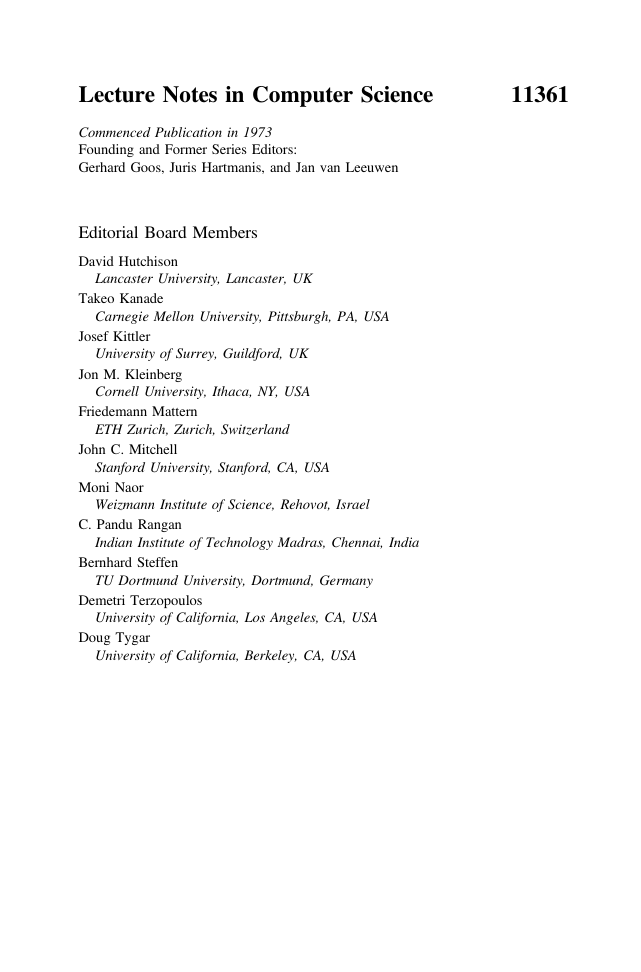

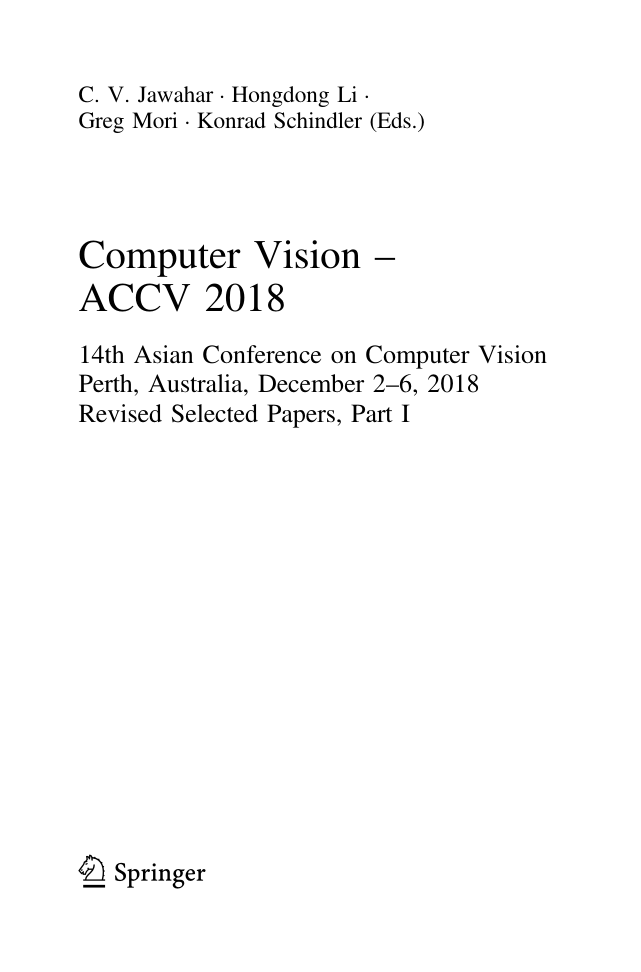
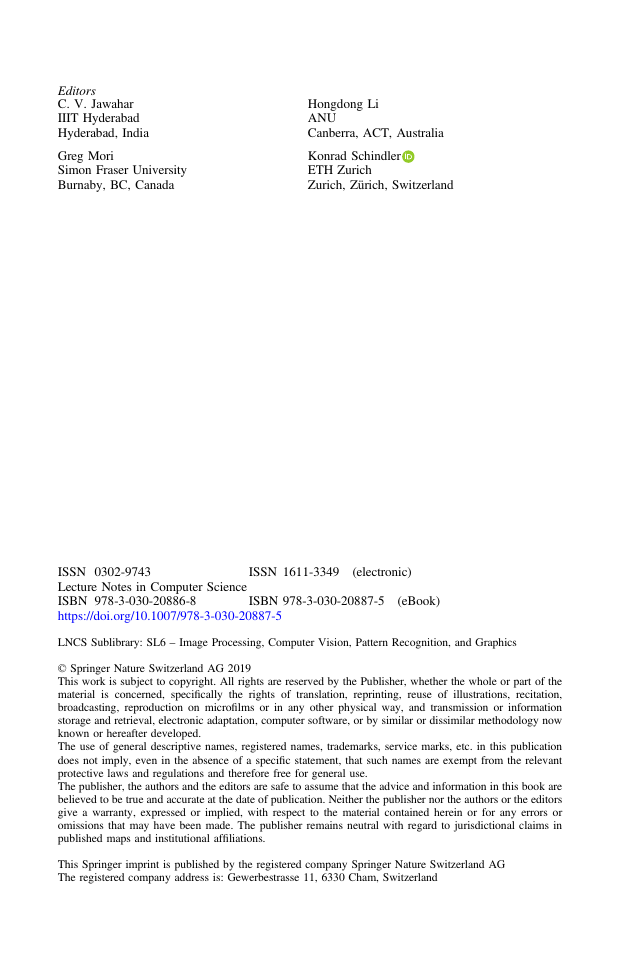
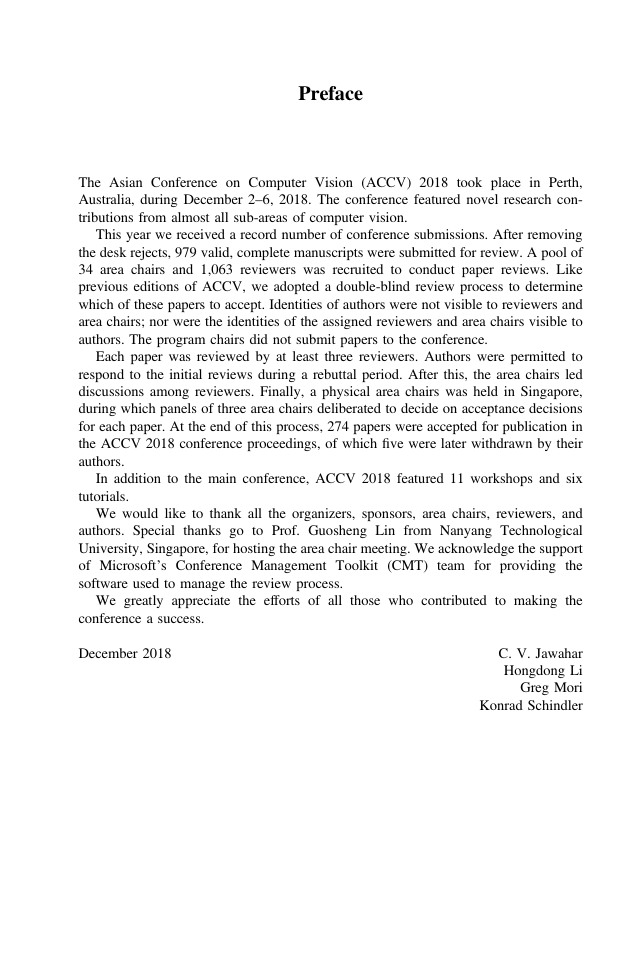
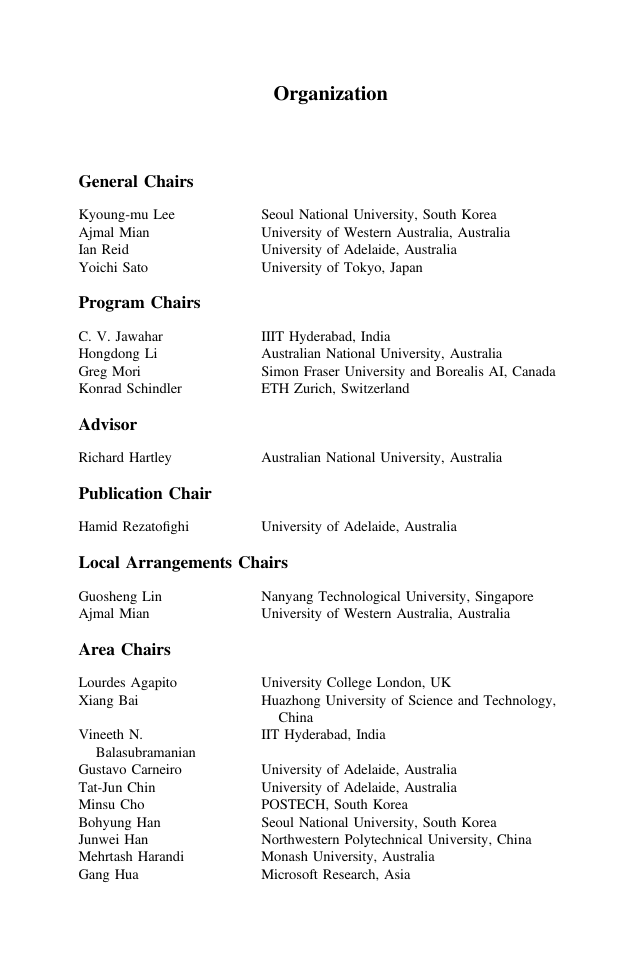









 2023年江西萍乡中考道德与法治真题及答案.doc
2023年江西萍乡中考道德与法治真题及答案.doc 2012年重庆南川中考生物真题及答案.doc
2012年重庆南川中考生物真题及答案.doc 2013年江西师范大学地理学综合及文艺理论基础考研真题.doc
2013年江西师范大学地理学综合及文艺理论基础考研真题.doc 2020年四川甘孜小升初语文真题及答案I卷.doc
2020年四川甘孜小升初语文真题及答案I卷.doc 2020年注册岩土工程师专业基础考试真题及答案.doc
2020年注册岩土工程师专业基础考试真题及答案.doc 2023-2024学年福建省厦门市九年级上学期数学月考试题及答案.doc
2023-2024学年福建省厦门市九年级上学期数学月考试题及答案.doc 2021-2022学年辽宁省沈阳市大东区九年级上学期语文期末试题及答案.doc
2021-2022学年辽宁省沈阳市大东区九年级上学期语文期末试题及答案.doc 2022-2023学年北京东城区初三第一学期物理期末试卷及答案.doc
2022-2023学年北京东城区初三第一学期物理期末试卷及答案.doc 2018上半年江西教师资格初中地理学科知识与教学能力真题及答案.doc
2018上半年江西教师资格初中地理学科知识与教学能力真题及答案.doc 2012年河北国家公务员申论考试真题及答案-省级.doc
2012年河北国家公务员申论考试真题及答案-省级.doc 2020-2021学年江苏省扬州市江都区邵樊片九年级上学期数学第一次质量检测试题及答案.doc
2020-2021学年江苏省扬州市江都区邵樊片九年级上学期数学第一次质量检测试题及答案.doc 2022下半年黑龙江教师资格证中学综合素质真题及答案.doc
2022下半年黑龙江教师资格证中学综合素质真题及答案.doc